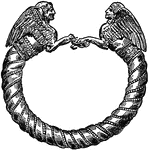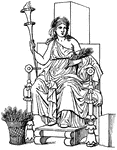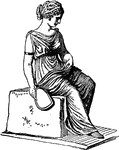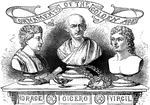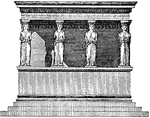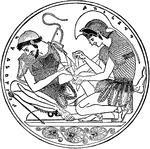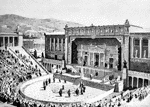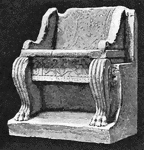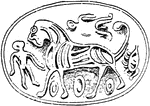The Ancient Greece ClipArt gallery offers 362 illustration of Greek history, events, and scenes of everyday life. For related images, please see Greek Mythology, Greek Architecture, Greek Ornament, Greek Coins, Greek Vases, and the Ancient Greek Musical Instruments ClipArt galleries.
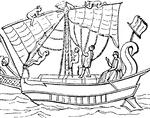
Greek Boat
"The masts were usually taken down when the vessel arrived in port, and raised again when it was about…

Ancient bows
"Represents two forms of the bow; the upper, the Scythian or Parthian bow enstrung, agreeing with the…

Boxing
"The Olympic games were of greater efficacy than the Amphictyonic Council in promoting the spirit of…

Bracae
"Trowsers, pantaloons, were common to all the nations which encircled the Greek and Roman population,…

Bronze Figure
"Bronze figure, originally applied a relief. Found at Tarentum. Apparently in the style of Lysippus."…
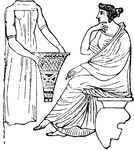
Calathus
"A slave, belonging to the class quasillariae, is presenting her misteress with the calathus,…
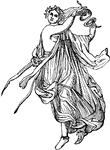
Calceus
"A shoe or boot, anything adapted to cover and preserve the feet in walking. The use of shoes was by…
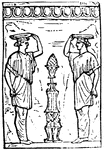
Canephoros
"A virgin who carried a flat circular basket at sacrifices, in which the chaplet of flowers, the knife…

Cestus
"The thongs or bands of leather, which were tied round the hands of boxers, in order to render their…
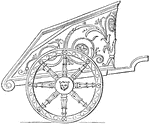
Chariot
"Arms and a chariot are here assigned to June through not properly a warlike goddess. The idea itself,…

Greek Chariot
"In the battles, as depicted by Homer, the chiefs are the only important combatants, while the people…
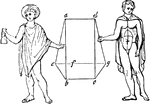
Chlamys
"The chlamys was a species of cloak or scarf, oblong instead of square, its length being generally about…
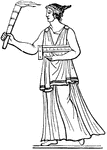
Cista
"A small box or chest, in which anything might be placed, but more particularly applied to the small…
Clavis
"A key. The key was used in very early times, and was probably introduced into Greece from Egypt; although…

Clipeus
"The large shield worn by the Greeks and Romans, which was originally of the circular form, and is said…
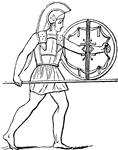
Clipeus
"The large shield worn by the Greeks and Romans, which was originally of the circular form, and is said…

Clisthenes in the Olympic Games
Clisthenes, also known as the Father of Athenian democracy, is depicted competing in a chariot race…

The Town and Isthmus of Corinth
View of Ancient Corinth looking North. The Gulf of Corinth is at the left and the isthmus is center…
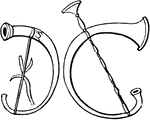
Cornu
"A wind instrument, anciently made of horn, but afterwards of brass. Like the tuba, it differed from…
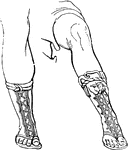
Cothurnus
"The cothurnus or buskin, rose above the midddle of the leg so as to surround the calf (sura),…
!["Afterwards [Solon] went to Sardis and made the acquaintance of Cresus. It was on this occasion that the celebrated interview occurred which has been so much repeated for its lesson. Cresus, desiring to make an impression on his visitor, took him into his treasury and showed him his riches."—Ridpath, 1885](https://etc.usf.edu/clipart/78900/78916/78916_treasures_mth.gif)
Cresus Showing Solon His Treasures
"Afterwards [Solon] went to Sardis and made the acquaintance of Cresus. It was on this occasion that…
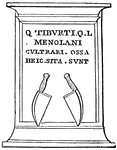
Culter
"A knife with only one edge, which formed a straight line. The blade was pointed, and its back curved.…

Tombstone of a cultrarius
"The preceding cut represents the tombstone of a cultrarius, or the individual who slew the…

Cyathus
"The crater was a vessel in which the wine, according to the custom of the ancients, who very…

Cyathus
"A Greek and Roman liquid measure, containing one-twelfth of the sextarius, or .0825 of a pint English.…

Banquet of Damocles
Image depicting a mythical moral anecdote, consisting of two morals. The first that regardless of who…
!["Here [Darius] was assassinated by Bessus, the satrap of Bactria. He was discovered by Alexander in a dying condition by the roadside. He asked for a cup of water, thanked the giver, and died. And with him died the Empire of the Persians."—Ridpath, 1885](https://etc.usf.edu/clipart/78900/78909/78909_dariusbody_mth.gif)
Alexander Discovers the Body of Darius
"Here [Darius] was assassinated by Bessus, the satrap of Bactria. He was discovered by Alexander in…

The Discus Thrower
Also known as Discobolus. The Discus Thrower is a famous, ancient bronze statue that demonstrates a…
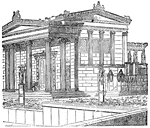
Erechtheum restored
"The building of the new Erechtheum was not commenced till the Parthenon and Propylea were finished,…
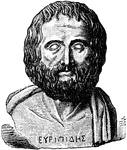
Euripides
"The next evolution is presented in Euripides. He is less ideal than his predeccesor, but truer to nature.…
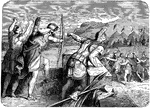
Astor to Philip's Right Eye
"It was during the siege of Methone that Philip had the misfortune to lose on of his eyes. A random…
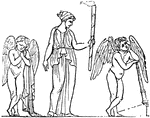
Fax
"A torch. In the annexed woodcut, the female figure is copied from a fictile vase. The winged figure…

Fibula
"A brooch, consisting of a pin, and of a curved portion furnished with a hook. The curved portion was…

Focus
"A fire-place; a hearth; a brazier. The fire-place possessed a sacred character, and was dedicated among…
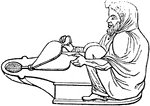
Follis
"Two inflated skins, constituting a pair of bellows. The following woodcut is taken from an ancient…
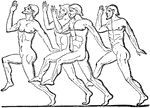
Foot-race
"The Olympic games were of greater efficacy than the Amphictyonic Council in promoting the spirit of…
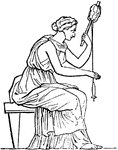
Fusus
"The spindle, was always, when in use, accompanied by the distaff, as an indispensable part of the same…

Galea
"A helmet; a casque. The helmet was originally made of skin or leather, whence is supposed to have arisen…
